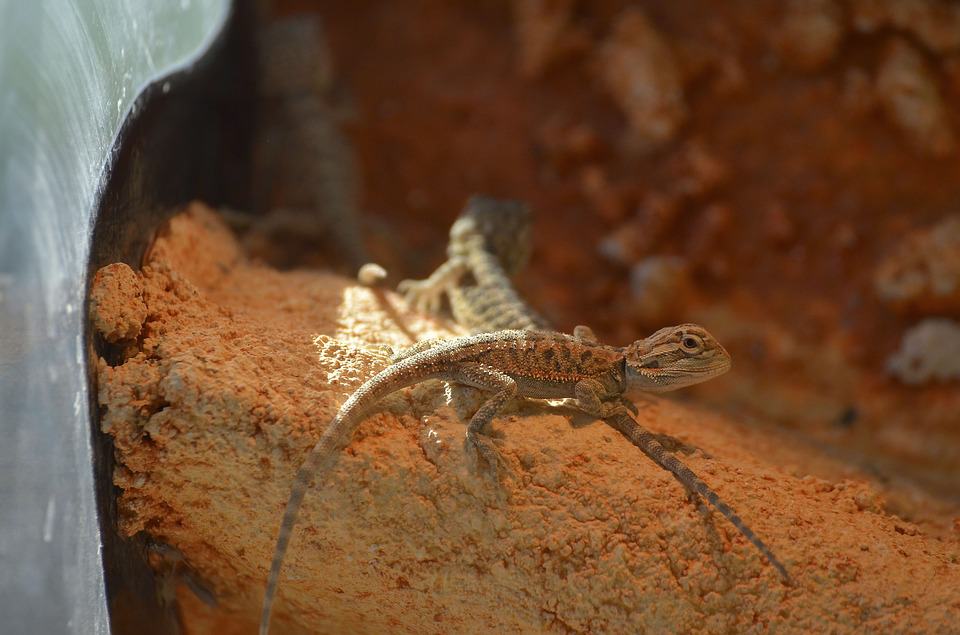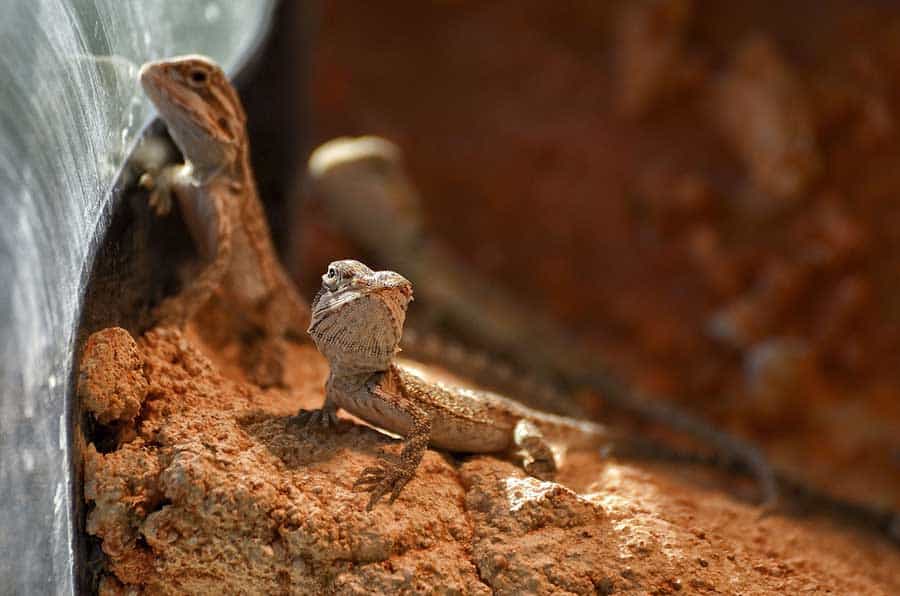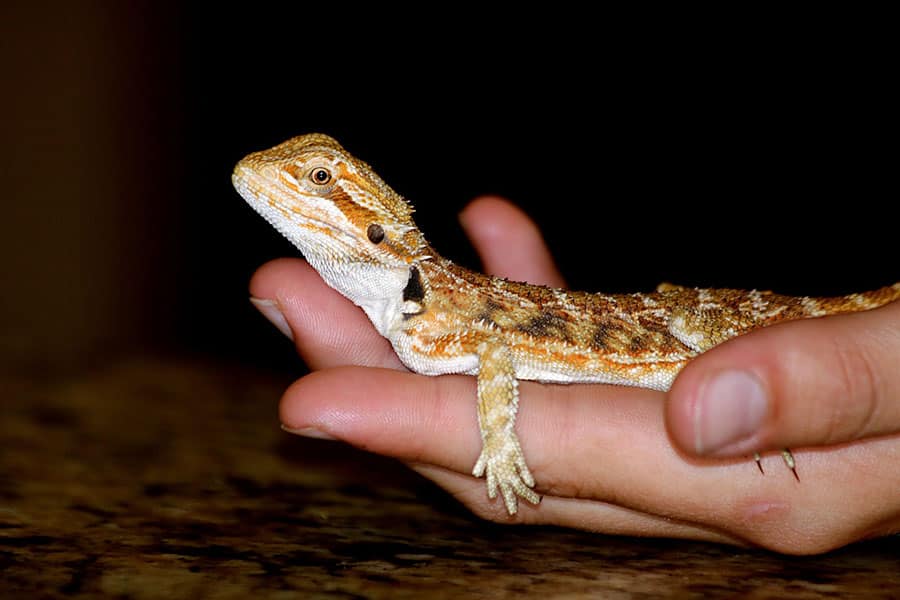When you’re making the move from furry babies to scaly ones, bearded dragons are a top choice. Experts recommend them as a safe first-time pet because it’s easy to manage baby bearded dragon care and setup. It’s why they outrank other lizards in popularity.
As far as their baby bearded dragon care, they don’t need much; a spacious tank, high-protein food, a misting bottle, tank substrate, a basking bulb, and a UVB bulb are the basics. As for what baby bearded dragons eat — like all growing babies, they need plenty of protein to stay healthy and strong.
This protein mostly comes from live or dried insects. In general, live bugs are better because they keep bearded dragons active. The babies have to chase down the food, which mimics the exercise they’d get in their natural habitat.
Beardies also get part of their protein and other nutrients from plants like leafy greens and a variety of other safe vegetables and fruits. Be careful with these though, since some can end up reversing the effects of other foods. Excess spinach and broccoli, for example, can reduce your beardie’s ability to process dietary
Your bearded dragon baby needs a wide range of foods to stay healthy and happy. In addition, they also require certain vitamin supplements – specifically
Baby Bearded Dragon Care: The Basics
There are tons of reasons why baby bearded dragons are such a popular first-time pet. They’re quiet, low-fuss, sociable, and cute. As they get older, their unique appearance lets you show them off to friends and family. It’s like owning a dinosaur…or an actual dragon!
Remember, though, when adopting a pet such as a bearded dragon, their diet is only the beginning of their care needs. Here are some other things you’ll need to provide for your growing baby beardie.
Enclosure
The first thing you’ll need is an enclosure to house your beardie. You can start with a smaller tank, around 10 or 20 gallons, if you plan to change it later. Since they are solitary animals, you should only have one dragon per enclosure. Later, you can put them in a 40+ gallon tank once they are nearing their full size.
REPTIZOO Large Glass Reptile
Always provide clean, fresh water in a dish on the cooler end of your beardie’s enclosure, and keep an extra dish in the tank for feeding time.
Substrate
ZeeDix 3pcs Natural Coconut Fiber Reptile Carpet Mat- Pet
In general, it is best to avoid loose substrates altogether to prevent impaction and keep the tank clean. If you use a loose substrate, your baby beardie may end up eating pieces of it during feeding time, which will build up in their digestive tract over time.
Substrates like tile, reptile carpet, and even paper towels will work just fine for your beardie’s enclosure.
The one area where it is safe to use loose substrate is in your beardie’s dig box; this will be a small, shallow box filled with moist, loose substrate.
Lighting
Zoo Med Heat UVB Reptisun Basking Spot Lamp (100 watts)
You’ll need to establish a temperature gradient in advance; the tank should be around 95 to 105°F under their basking bulb and around 85 to 90 degrees on the cooler side. Get a 12 to 14-inch UVB tube light that covers most of the enclosure to help them absorb
Mount this light above the tank and inside it if possible, as the mesh screen on top of the tank will filter out much of the UVB rays your beardie needs to thrive. You’ll also need a plain white
The basking bulb and heat emitter will help them stay warm and aid in digestion. Basking bulbs should be anywhere from 60W to 100W depending on the size and setup of your beardie’s enclosure. The hottest area of the tank, or underneath the basking bulb, should be around 95 to 110°F.
Meanwhile, the cool side of the enclosure should be between 80 to 90°F. A dual
What Do Baby Bearded Dragons Eat? Some Popular Foods
Originally, bearded dragons were imported to countries like the US and the UK from the Australian Outback. These days, however, bearded dragons sold by breeders and pet stores are born and raised in various locations all over the world.
Bearded dragons’ diets in the wild are usually an omnivorous mix of ‘meat’ from insects and a small amount of ‘greens’ from vegetables or fruit they manage to scavenge. In captivity, much of this is the same, though they typically have access to a much wider range of foods than they would in their natural habitat.
While you have a diverse range of foods to consider, there are a few to stay away from. For example, one thing you may want to avoid is citrus fruits. Oranges, lemons, and grapefruit are great for humans, but they are too acidic for bearded dragons. If you serve these citrusy snacks, your beardie will still eat them, but they are likely to later get an upset stomach and have runny, especially stinky stools.
Below are some of the most common and nutritious foods fed to bearded dragons in captivity. Adults and babies eat the same types of food overall, but babies are much heavier on protein while adults rely more on plant matter.
As a general rule, baby bearded dragons’ diets should be made up of around 80% insect protein and 20% plant matter, while adults should have the opposite ratio: 80% plant matter and 20% insect protein. As your baby bearded dragon ages, you’ll need to gradually adjust this ratio accordingly.
Dubia Roaches
Dubias are the best food you can feed to bearded dragons of all ages when it comes to insects. They are especially great for growing baby beardies. Plus, these roaches are prolific breeders, so if you choose to breed them on your own, you could potentially save thousands of dollars over the course of your beardie’s life.
Keep them in a secured container, though, and oil the tops of their crates. Otherwise, your home will soon be overrun by roaches.
Pros
- They’re crunchy and full of
calcium . - They have maximum protein and minimal fat.
- They can live up to two years as live feeders.
Cons
- These roaches are illegal in places like Florida, so depending on your location, you can’t always find them.
Crickets and Grasshoppers
These jumpy jitterbugs are the ultimate treat for bearded dragons. Hunting them offers good exercise, as long as they can fit in your beardie’s mouth. They’re a good source of
Pros
- They’re easy to gut-load with foods like oats and potatoes.
- They offer lots of
calcium and a satisfying crunch. - They’re cheaper if you order by the crate.
Cons
- Crickets aren’t particularly hardy bugs, so some may die before feeding time.
Worms (Various)
These include bugs like superworms, waxworms, mealworms, and hornworms. These invertebrates are soft and squishy with thin, crunchy exoskeletons, so your beardie will love slurping them up. You can buy them from local pet shops or online or breed them in egg crates and plastic containers so your beardie always gets them fresh.
Pros
- They’re easy to breed and gut-load.
- Their bulk and texture are satisfying for your beardie.
- Live worms like waxworms go dormant when frozen, so you can store and later thaw them for your beardie’s delicious, wriggly meals.
Cons
- Some varieties such as waxworms and superworms are high in fat, so they can cause beardie obesity if you overfeed them.
Larvae
Symton Large Feeding Grade Black Soldier Fly Larvae
Black soldier fly larvae combine the stimulation of live food with the convenience of prepacked shipping. They are gut-loaded with grass, grains, and probiotics, so they provide a healthy and balanced treat for your bearded dragon. Each grub is only 0.25 inches long, so they’re perfectly sized for baby beardies.
Pros
- They have lots of natural
calcium and phosphorus. - They come live and can last for two weeks.
- Grubs are wriggly and hyper so your beardie will love chasing them.
Cons
- You can typically only order enough for two weeks at a time, and they need careful storage.
Vegetables
Offer dark, leafy greens like turnip greens, dandelion greens, clover, Swiss chard, and watercress. Other safe veggies include bell peppers, endive, and various types of squash, such as the butternut and acorn varieties.
Avoid cabbage and kale, since they can interfere with beardie hormones. Spinach, Brussels sprouts, and broccoli are rich
Remember, baby beardies should only be eating a small amount of plant matter (or around 20% of their total food intake) at this point in their lives. As they grow older, begin feeding them more veggies.
Pros
- Their fiber content helps beardies with digestion.
- They’re rich in iron and minerals.
- Vegetables are generally cheaper than insects and worms.
Cons
- Some greens like lettuce are low in nutrients and mostly full of water. Others like spinach can bind
calcium . Avoid these ‘junk greens,’ and focus on healthy ones instead.
Fruits
When it comes to your baby beardie’s fruit intake, focus on tart fruits like strawberries and raspberries, because overly sugary fruits can fatten your beardie. Other safe fruits include mango, blueberries, bananas, and apples, but only feed them in small amounts.
Overall, fruit should only make up about 5% to 10% of your beardie’s diet. This also applies to juvenile, sub-adult, and adult dragons.
Pros
- Fruits need minimal preparation – just rinse them, cut them up, and remove any skins and seeds.
- They’re easy to digest, so they’re a quick energy source.
- Fruits come in a variety of different textures and flavors your beardie will love.
Cons
- Many fruits are soft, sweet, and sticky, so they can damage your beardie’s teeth.
- Since they are fairly high in sugar, if fed too often, fruits can cause obesity in bearded dragons.
Bearded Dragon Dietary Supplements
In the wild, bearded dragons get their nutrients wherever and whenever they can find them. But with captive scale babies, you can keep them healthier and living much longer than they would in the wild by adding the right supplements to their diet. These can be offered as powders you dust their food with, gut-loaded into insects, or provided in liquid formulations.
Calcium
Calcium helps your bearded dragon develop strong teeth, bones, and scales. It comes in powdered form or liquid drops that can be fed via syringe. Low
Phosphorus
Bearded dragons, particularly babies, need both phosphorus and
You should look for a supplement that has
Vitamin D3
Humans need vitamin D, but bearded dragons need D3. Their bodies don’t store it naturally, but UVB rays help them manufacture it. Your bearded dragon needs either direct sunlight or viable UVB lamps to generate D3, and this in turn helps their bodies absorb and process
Probiotics
Good bacteria are a helpful supplement for bearded dragons. They balance out your beardie’s biome and can help flush out parasites and harmful bacteria. Probiotics are best given as part of a multivitamin supplement. This way, all those minerals are proportionally balanced and provided in one product.
How Often Should You Feed a Baby Bearded Dragon?
You’ll probably buy or adopt your baby bearded dragon when they’re just 6 to 10 weeks old or roughly two months. Most breeders and pet shops won’t sell them any earlier, as beardies are very fragile during their first few weeks of life.
As hatchlings, baby dragons must eat very frequently to support their rapidly growing bodies. You’ll need to feed them as often as five or six times per day until they reach three months old. Offer one bug at a time, and feed them as many as they’ll eat in a 10 to 15-minute feeding session.
After your beardie reaches three months of age, you’ll need to feed them about three or four times a day in 10 to 15-minute sessions. Again, only offer one insect at a time, and wait until your scale baby chews and swallows it before offering more.
You should also offer vegetables and a very small amount of fruit in their food bowls a few times per day, dusting them with
After every 10 to 15-minute feeding session, carefully remove any leftovers and compost them if you wish. Leaving leftover insects and plant matter inside the tank can cause parasites and diseases. If you’re using a loose substrate, consider feeding your bearded dragon outside the tank for quicker clean-up.
For every meal, you’ll ideally end up feeding your baby bearded dragon anywhere from 5 to 10 small insects (crickets, mealworms, etc), one portion of veggies like squash or bell pepper, two portions of dark, leafy greens, and one small portion of fruit like bananas, blueberries, apples, or pears.
How Often Should You Feed a Juvenile Bearded Dragon?
Juvenile bearded dragons should eat three or four times a day, still in 10 to 15-minute sessions. Ensure they get their
At every meal, your juvenile bearded dragon can munch on mostly the same feeding template as baby bearded dragons, though they should now be getting slightly more plant matter in their diet.
For example, instead of feeding 5 to 10 crickets or worms at a time, combine five crickets and five worms with extra vegetable portions and a serving of fresh fruit. You can try mixing up a salad for them with all of these ingredients! Remember, like with baby dragons, you’ll need to always remove any uneaten food after each meal.
Whenever you serve leafy vegetables to your bearded dragon, mist them with fresh water. Misting your beardie’s food is a fast, easy, low-humidity way to keep them hydrated. Plus, it mimics their natural habit of drinking dew off grass and leaves in the wild.
Note that the number of insects per meal is never reduced as your beardie ages. Rather, the plant matter is increased, and the number of daily feedings go down as your bearded baby gets bigger. By the time they reach full size, they will primarily be eating veggies and fruits and around 10 insects per day.
FAQs About Baby Bearded Dragon Care
You’re now familiar with the basics of how to feed and raise a baby bearded dragon, but you may still have questions regarding their dietary habits. Here are our responses to a few of those questions.
How do you know your beardie is getting enough to eat?
As long as your bearded baby is pooping every day and growing steadily, they’re getting enough food.
Check the nature of their poop, though, as this will show you if they have any digestive issues. It may also inform you of certain foods your beardie should avoid. If too much of that food passes through their system undigested and ends up in their poop or a certain food causes runny stools, you probably want to avoid it.
Many pet parents like to feed their babies off their plates. If you’re eating vegetables or a beardie-safe fruit, it’s okay to let them have a nibble.
Fruits low in sugar and raw vegetables are best. Cooked food may have spices and other additives that won’t do your beardie any favors. Also, bearded dragons don’t need starch, so don’t share your carbs with your scale baby.
What can you feed your baby beardie to help their digestion?
If your baby bearded dragon hasn’t pooped for a day or two, they might be impacted or mildly constipated.
Mist their nose and mouth and give them a bath. This both hydrates them and stimulates pooping. You can feed them natural laxatives like olive oil or soft foods like pumpkin, squash, or apple sauce. Puree or blend these before giving them to your beardie with a spoon.
Can a baby bearded dragon eat adult food?
The kind of food that baby and adult beardies eat is the same. So yes, a baby can eat adult food. The difference is in the sizing and proportion.
To avoid beardie babies choking, check the size of the gap between their eyes, and don’t feed them any foods wider than said gap.
Also, while the food categories are the same, adults mostly eat plants, while babies eat a much higher volume of insects.
How do I know if my baby bearded dragon has a vitamin or nutrient deficiency?
Calcium deficiency is the most common food deficiency in bearded dragons, and it is particularly harmful for growing baby beardies.
If your baby bearded dragon is lacking
Other warning signs include persistent crouching due to weakened limbs, swollen jaws that feel rubbery, swelling in your beardie’s back legs, bent bones, and trembling when they walk. Feed liquid
Wrapping Up: Baby Bearded Dragon Diets
Baby bearded dragons are called hatchlings. They’re considered to be babies until they reach roughly six months. When they’re born, they only weigh 0.14 ounces on average and are 3 or 4 inches long. During the first year of their life, they will grow a few inches every month.
Overall, baby beardies need 80% insect protein and 20% plant matter in their diets. The protein comes from bugs like crickets and worms, while the plant matter comes from fruits and vegetables. Always make sure any food you give your baby bearded dragon is smaller than the width of the space between their eyes to prevent choking or impaction.




